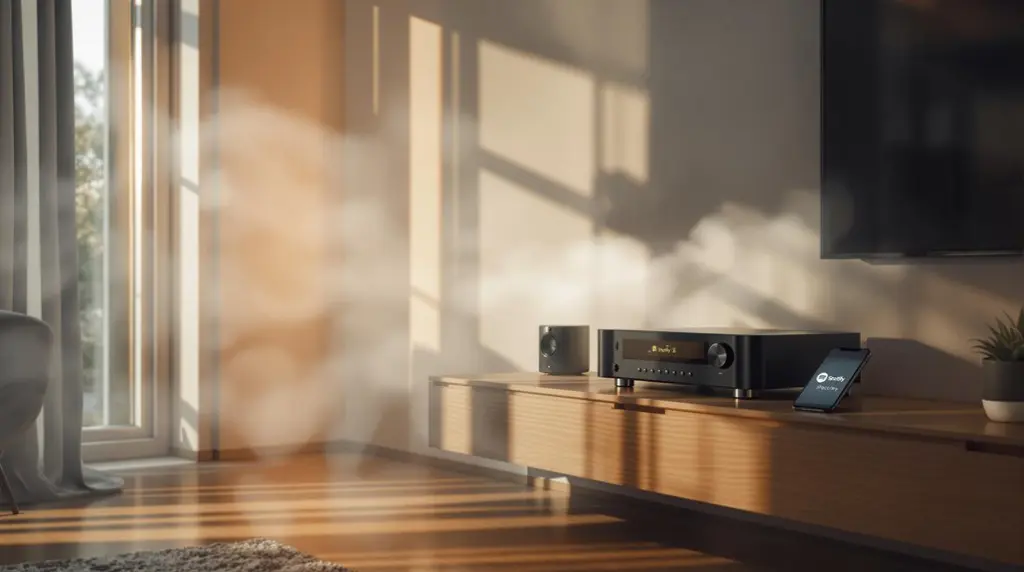Mastering advanced beatgridding in DJ software involves meticulous marker placement to align with track beats, leveraging both automatic and manual adjustments to guarantee precise beatmatching and looping. Accurate beatgrids facilitate seamless shifts and enhance functionalities like syncing and effects application, essential for maintaining rhythmic integrity. Techniques such as dynamic beatgridding and applying beat warp markers accommodate tracks with variable tempos, assuring grid stability. By fine-tuning grids through manual editing and utilizing advanced tools, DJs can achieve professional-level performances. Explore specific methods and tools to boost your skills and performance quality.
Key Takeaways
- Accurate beatgridding ensures smooth transitions, consistent rhythm, and effective tempo management during DJ performances.
- Manual adjustments and warp markers allow precise alignment of beat markers with track transients, accommodating variable tempos.
- Advanced beatgridding tools like dynamic beatgridding and timestretch algorithms maintain audio quality while adjusting playback speed.
- Regular drift checks are essential to ensure synchronization with beat markers and transients throughout playback.
- Beatgrid creation involves aligning the downbeat marker with the first strong beat and fine-tuning grid markers for accuracy.
What Is Beatgridding?
Beatgridding is a fundamental process in DJ software that involves the meticulous placement of a grid of markers to align with the beats of a track, guaranteeing precise synchronization and mixing of multiple songs.
The beatgrid basics include the use of downbeat markers, beat markers, and bar markers. Downbeat markers, often represented by thick red lines, indicate the start of a measure, while thin white lines denote individual beats, and thick lines every four beats signify bar markers. These markers provide a visual framework to maintain consistent tempo and facilitate seamless changes.
Advanced beatgrid strategies involve both automatic and manual methods for peak accuracy. DJ software can automatically generate beatgrids through real-time track analysis, but manual adjustments are often necessary to address any discrepancies, particularly in tracks with variable tempos. This guarantees that the beatgrid aligns perfectly with the track’s rhythmic structure.
The precision of beatgridding enhances core functions such as beatmatching, looping, and quantization, enabling DJs to execute complex changes and effects synchronization.
Mastery of beatgrid strategies therefore expands the creative capabilities available during live sets, allowing for a more dynamic and engaging performance.
Importance of Accurate Beatgrids
Understanding advanced beatgridding techniques is only the first step towards mastering the art of seamless DJ performance. Beatgrid accuracy is paramount for ensuring that shifts between tracks are smooth, maintaining a consistent rhythm and flow. This precision allows DJs to manage tempo variations effectively, particularly in live recordings or genres with intentional tempo fluctuations.
Without accurate beatgrids, DJs would often rely on averaged BPM values, which can lead to misalignment and disrupt the mix. Additionally, integrating real-time effects manipulation can further enhance the dynamic nature of live sets, making beatgrid precision even more essential.
Proper beatgridding plays a vital role in performance enhancement by optimizing the functionality of key features within DJ software. Looping, syncing, and effects application become more reliable and intuitive, enabling DJs to focus on their creative expression rather than technical corrections.
An inaccurate beatgrid, on the other hand, can result in misaligned tracks and disruptions, detracting considerably from the audience’s experience.
The ability to manually adjust and customize beatgrids further enhances performance quality. By tailoring beatgrids to fit the unique characteristics of each track, DJs can refine their mixing techniques, ensuring that each set is a polished, cohesive performance.
Accurate beatgrids are thus not just a technical necessity but a fundamental aspect of professional DJing.
Tools for Beatgridding
Harnessing advanced tools for beatgridding is vital for achieving professional-level DJ performances. Beatgrid software such as DJ.Studio and Traktor Pro provides both automatic and manual beatgridding options, offering DJs the precision needed for impeccable beatmaps. These tools integrate AI-driven adjustments, enabling the fine-tuning of grid markers to match the track’s unique rhythmic structure accurately.
The implementation of drag-and-drop functionality in many DJ platforms simplifies the alignment of beatgrid markers with track transients. This feature is essential for guaranteeing perfect synchronization during live mixes. Additionally, warp markers present in these software solutions allow DJs to manipulate specific sections of a track to accommodate tempo changes seamlessly, enhancing flexibility during live performances.
Another significant feature is the capability to export beatgrids, which allows DJs to transfer customized grids between different DJ programs. This functionality guarantees workflow efficiency and consistency across various setups, which is indispensable for maintaining performance quality.
| Software | Key Features | Application |
|---|---|---|
| DJ.Studio | AI-driven adjustments, drag-and-drop | Precision beatmapping |
| Traktor Pro | Warp markers, export capabilities | Flexibility in live mixes |
| Serato DJ Pro | Customizable beatgrid markers | Consistent performance |
| Rekordbox | Seamless beatgrid export | Cross-software integration |
Creating Beatgrids Manually
Manually creating beatgrids is a meticulous process that demands a keen ear and precise attention to detail. It begins with enabling the beatgrid feature in your DJ software’s setup. The first step is to analyze the track and place initial markers corresponding to the song’s beats, providing a foundational beatgrid. This foundational work is essential for the automation of mixing processes, which can greatly streamline your workflow.
To guarantee accurate representation of the song’s rhythmic structure, adjust the downbeat marker to align with the first strong beat of the track. This alignment is critical for effective and seamless mixing.
Grid edit mode is indispensable for making manual adjustments, allowing for precise repositioning of beat markers to address any misalignments due to tempo variations or irregular rhythms.
Utilize beat warp markers to either stretch or contract sections of the track. This technique is necessary for accommodating tempo changes and maintaining a consistent beatgrid during playback. Regularly checking for drift throughout the track and making necessary adjustments is essential to preserve synchronization with the beat markers and transients.
Key steps for manually creating beatgrids include:
- Enabling the beatgrid feature in DJ software
- Analyzing the track for initial beat placement
- Aligning the downbeat marker with the first strong beat
- Using grid edit mode for precise manual adjustments
- Applying beat warp markers to handle tempo variations
Editing Beatgrid Errors
Precision in beatgridding is essential for achieving seamless shifts in DJ performances. Editing beatgrid errors involves meticulous manual adjustments to guarantee beat markers align accurately with the track’s transients, thereby optimizing beatgrid synchronization. DJs must regularly check for drift by listening to the track and comparing the beatgrid against the waveform to identify discrepancies requiring error correction.
| Tool/Feature | Function | Benefit |
|---|---|---|
| Manual Adjustment | Aligns beat markers with transients | Guarantees accurate synchronization |
| Grid Edit Mode | Stretches, contracts, or slips the beatgrid | Accommodates tempo variations |
| Beat Warp Markers | Locks specific points in the track | Provides flexibility for complex rhythms |
| Drift Checking | Compares beatgrid with waveform | Identifies discrepancies for correction |
| Beatgrid Export | Transfers adjustments between software | Consistent performance across environments |
Utilizing the Grid Edit Mode, DJs can stretch, contract, or slip the beatgrid, allowing for precise adjustments that accommodate tempo variations within the track. Beat Warp Markers can be manually created to lock specific points, providing greater flexibility for complex rhythmic structures or live recordings. In addition, many DJ software platforms support beatgrid export, enabling DJs to transfer their customized beatgrids across different software environments, guaranteeing consistency in performance. This meticulous approach to beatgrid optimization and error correction is vital for maintaining the integrity of a mix, especially during live performances.
Syncing Techniques
In the domain of syncing techniques, leveraging Beat Sync Mode and Tempo Sync Mode is essential for achieving seamless changes and consistent BPM across tracks.
While automatic sync features provide a foundational layer of tempo alignment, manual beat adjustments are vital for addressing discrepancies, especially with hardware like motorized platters.
Mastering these techniques, including the strategic disengagement of Sync and utilizing Instant Playback capabilities, guarantees precise and fluid performance in dynamic DJ sets.
Additionally, understanding the nuances of manual beat matching and pitch control can greatly enhance your ability to manage changes and maintain rhythmic coherence.
Automatic Sync Features
Automatic sync features have revolutionized DJ performances by enabling seamless tempo alignment across tracks, consequently allowing DJs to prioritize artistic expression over technical fine-tuning. At the core of these features lie sophisticated syncing algorithms, which guarantee that tracks maintain precise tempo synchronization, thereby optimizing performance.
One pivotal aspect is the Beat Sync mode. When engaged, it sets a master tempo for all subsequent tracks that enter Sync mode, guaranteeing consistent tempo alignment even when manual adjustments are made. This mode is instrumental in maintaining a coherent rhythmic flow throughout a DJ set.
Similarly, Tempo Sync mode focuses on matching the tempo of decks in Sync mode, allowing DJs to manipulate tracks without disrupting their rhythmic integrity.
Many DJ software packages further enhance syncing capabilities through instant playback and smart sync functions. These features snap beat grids of multiple tracks together, facilitating accurate beatmatched mixing. However, regular drift checks are imperative to guarantee that beat markers remain aligned with transients, maintaining synchronization accuracy throughout the performance.
- Sophisticated syncing algorithms
- Beat Sync and Tempo Sync modes
- Instant playback for seamless shifts
- Smart sync for precise beatmatching
- Regular drift checks for sustained accuracy
Manual Beat Adjustment
While automatic sync features provide a robust foundation for maintaining tempo consistency, achieving impeccable beat alignment often necessitates manual beat adjustment techniques. In DJ software, manual beat adjustment involves leveraging beatgrid editing tools to fine-tune beat marker placement, guaranteeing precise alignment with the track’s transients. This is particularly essential for tracks exhibiting tempo fluctuations, where automatic synchronization may not suffice.
Engaging Beat Sync mode guarantees automatic tempo synchronization, but manual adjustments are critical to correct any misalignments, especially when dealing with fluctuating BPMs. The downbeat marker, serving as the reference for the first beat of each bar, can be manually adjusted to rectify any drift within the beatgrid, guaranteeing consistency throughout the track.
Furthermore, utilizing nudge adjustments is indispensable for DJs during live performances, allowing for small, temporary speed modifications to achieve tighter synchronization with the beatgrid. This technique is necessary for real-time corrections, maintaining seamless shifts between tracks.
Regularly checking for drift and employing tools such as the metronome aids in manual beatgrid alignment, enhancing the overall mix quality. Mastering manual beat adjustment techniques is fundamental for professional-grade DJing, enabling precise control over track synchronization.
Tempo Matching Tips
Mastery of tempo matching is vital for DJs aiming for flawless changes and impeccable beatmatching. Leveraging advanced sync techniques in DJ software can greatly enhance your performance. Utilizing Beat Sync mode guarantees precise tempo adjustment between tracks, allowing for seamless shifts and accurate beatmatching. This feature is particularly useful during live performances where timing is essential.
Engaging Tempo Sync mode takes this a step further by automatically matching the BPM of multiple decks, enabling consistent tempo throughout your set. This consistency is key for complex manipulations and layering of tracks.
Regularly checking for drift between tracks is essential; listen for misalignments and manually adjust Beat Warp Markers as necessary to maintain synchronized beats.
Practicing with the metronome functionality in your software can train your ear for precise timing, guaranteeing your beatgrids align accurately with the music’s beats. Becoming proficient with your software’s specific sync features, such as enabling or disabling sync for individual decks, grants greater control over your mixing techniques.
- Utilize Beat Sync mode for precise tempo adjustment
- Engage Tempo Sync mode for consistent BPM across decks
- Regularly check for drift and adjust Beat Warp Markers
- Practice with metronome functionality to train timing
- Familiarize with sync features for individual deck control
Handling Variable Tempos
Maneuvering variable tempos within DJ software presents a substantial challenge due to the inherent limitations of traditional beatmatching algorithms, especially when dealing with tracks characterized by live drumming or deliberate tempo shifts. The key to mastering tempo manipulation lies in leveraging advanced beatgridding modes, such as dynamic beatgridding. This sophisticated approach allows DJs to implement real-time dynamic adjustments, guaranteeing accurate synchronization even as the tempo fluctuates.
Understanding beatmatching fundamentals and harmonic mixing can further enhance the effectiveness of these techniques.
Utilizing manual beatgridding techniques, DJs can achieve superior precision by strategically placing Beat Warp Markers. These markers facilitate the creation of a grid that adapts to tempo variations throughout the track, thereby maintaining the integrity of the rhythm.
Additionally, software capabilities often include locking beatgrid anchors, which are essential for preserving grid stability during shifts. This feature guarantees that syncopated rhythms and varying tempos align seamlessly.
Moreover, modern timestretch algorithms empower DJs to modify playback speed without altering the pitch, preserving audio quality while managing tracks with inconsistent tempos.
This combination of advanced tools and techniques assures that DJs can handle variable tempos with professional finesse, delivering a polished and cohesive auditory experience.
Advanced Beatgridding Tips
Frequently, DJs encounter the intricacies of advanced beatgridding as they aim for seamless shifts and precise beatmatching. Mastery of this technique not only amplifies your creative changes but also guarantees a polished live performance.
Here are some advanced tips to boost your beatgridding skills:
- Dynamic Beatgridding Modes: Utilize dynamic beatgridding modes in your DJ software to manage tracks with variable tempos, particularly in genres like live rock and jazz where tempo fluctuations are common.
- Advanced Timestretch Algorithms: Employ advanced timestretch algorithms to maintain pitch while adjusting playback speed, facilitating manual beatgridding by marking beats accurately along the track. While using these algorithms, it’s important to align visual waveforms to attain precision.
- Checking for Drift: Regularly check for drift in your beatgrid by confirming beat markers align with transients throughout the track. This practice allows for seamless shifts and accurate beatmatching.
- Beatwarp Markers: Experiment with beatwarp markers to create flexible beatgrids that can accommodate tempo changes, enhancing your mixing capabilities during live performances.
- Community Resources: Take advantage of community resources, such as video tutorials and mini-courses, to master advanced beatgridding techniques and improve your overall mixing skills.
Community and Resources
The DJ community’s extensive repository of resources greatly enhances a DJ’s ability to master advanced beatgridding techniques. With over 150,000 members, the community thrives on robust community engagement and resource sharing. Exclusive access to training videos, articles, and tutorials provides DJs with the tools necessary to perfect their craft, particularly in genres with variable tempos such as disco and funk.
Weekly newsletters keep members abreast of the latest DJ news, reviews, and tips, ensuring they remain at the forefront of industry trends and techniques. The availability of free mini-courses and video tutorials on advanced beatgridding techniques is invaluable, offering structured learning paths for DJs seeking to refine their skills.
Active participation in forums and discussions facilitates a collaborative environment where DJs can share experiences, seek advice, and solve beatgridding challenges collectively. Additionally, organizations frequently host contests and giveaways, like a personalized Minirig 4 speaker bundle, to incentivize and reward community participation.
| Resource Type | Availability | Benefits |
|---|---|---|
| Training Videos | Exclusive to Members | Enhances beatgridding skills |
| Weekly Newsletters | Distributed to Members | Updates on trends and techniques |
| Free Mini-Courses | Accessible Online | Structured learning |
| Forums & Discussions | Open to Community Members | Experience sharing and advice |
This ecosystem of shared knowledge and active community engagement is pivotal in advancing a DJ’s proficiency in beatgridding.
Frequently Asked Questions
How to Use Beat Grid?
To use a beat grid, initiate automatic analysis within your DJ software, followed by manual beat grid adjustment to correct any discrepancies. Assure beat grid alignment through tools like metronome and beat warp markers for precise synchronization and superior mixing.
What DJ Software Do Most DJS Use?
The DJ software trends indicate that Serato DJ Pro, Rekordbox, Traktor Pro, and Virtual DJ are the most popular DJ platforms. Each offers unique features suitable for different DJing styles, with Serato DJ Pro and Rekordbox leading in professional use.
What Is Beat Gridding?
Beat gridding entails utilizing beat grid techniques to align markers with a track’s waveform, facilitating precise tempo synchronization. This process guarantees accurate beat matching, looping, and effects application, critical for seamless shifts and professional-level DJ performances.
What Software Do DJS Use on Stage?
DJs commonly use Serato DJ Pro, Traktor Pro, Rekordbox, and Virtual DJ during DJ performances for live mixing. Each software offers advanced features and industry-specific tools, catering to professional and personalized setups for seamless integration and superior control.
Conclusion
The integration of advanced beatgridding techniques within DJ software is pivotal for achieving precise rhythmic alignment, enhancing the synchronization of tracks, and ensuring seamless changes during performances. Mastery of tools and methods for creating, editing, and managing beatgrids, particularly in the context of variable tempos, is essential for professional-grade output. Leveraging community resources and staying abreast of technological advancements further solidify the expertise required for proficient beatgridding, ultimately elevating the quality of DJ sets.




